Page Table of Contents
About the Author
Hot Topics
Updated on Nov 27, 2024
Follow the solutions to fix Windows 10 or SSD slow after clone:
| Workable Solutions | Step-by-step Troubleshooting |
|---|---|
| Fix 1. SSD 4K Alignment | Go to "Toolkit" and choose "4K Alignment"...Full steps |
| Fix 2. Enable AHCI and Update Drivers | First, open the "Search" box of Windows and type "cmd"...Full steps |
| Fix 3. Free Up Space on C Drive | Click "Adjust with 1-Click" to extend C drive...Full steps |
| Fix 4. Enable TRIM for SSD | Start by accessing the "Command Prompt" app by searching it...Full steps |
| More fixes |
Disable Disk Indexing...Full steps |
Cloning Windows means making an exact copy of a computer and putting it on another with just a click. Yet, there's a drawback to this facility where you often face the issue of sluggishness after clone HDD to SSD. Why is Windows or Laptop still slow after an SSD upgrade or SSD clone?
Several factors can contribute to this problem, like outdated drivers, low storage on Windows drives, etc. You can swiftly restore your system's performance and speed with the right approach and a few troubleshooting steps. Follow this guide to learn how to fix the Windows 10 slow after clone issue.
How to Fix Windows 10 Slow After Clone
It is normal for Windows 10 to get slow after cloning it on a different PC, as we mentioned the factors above for it. This section of the guide will help you learn about several well-working methods:
Method 1. SSD 4K Alignment
SSDs commonly use a larger sector known as 4K (4096 bytes) rather than the 512 bytes of HDDs. However, if SSD partitions are not aligned to the 4K boundaries, extra work may be needed to read and write data, resulting in SSD slow after clone. This misalignment can occur when cloning a Windows 10 system from a source drive with a different alignment or using improper cloning methods.
To fix this "SSD slow after clone" issue, EaseUS Partition Master Professional comes to the rescue with its powerful features. This tool is one of the best partition managers for Windows users to handle almost every partition-related task of storage drives. With its 4K alignment function, you get optimized and speedy SSD performance in a few clicks.
Step 1. Go to "Toolkit" and choose "4K Alignment".
Step 2. Select the disk you want to align. Click the "Start" button.
Besides, with this tool, you can also change SSD allocation unit size and cluster size to improve the speed.
Method 2. Enable AHCI and Update Drivers
AHCI is a communication standard that allows the operating system to communicate well with SSDs. So, enabling AHCI mode ensures the SSD can utilize advanced features and performance enhancements.
Also, older drivers may lack optimizations for specific hardware configurations of modern SSDs. Hence, updating drivers for the storage controller is one of the simplest solutions. Follow this detailed guide to achieve this and fix Windows 10 slow after the clone problem:
Step 1. First, open the "Search" box of Windows and type "cmd." Afterward, hit the right-click button on "Command Prompt" and then "Yes" in the UAC window after choosing "Run as Administrator."
Step 2. Type the "bcdedit /set {current} safeboot minimal" command in the Command Prompt window and hit "Enter."
Step 3. Once done, reboot the system and press the F2 key while starting up to access BIOS and enable AHCI.
Step 4. After that, press F10 to save your changes and exit.
Step 5. Now, open the Command Prompt again after restarting Windows and type the "bcdedit /deletevalue {current} safeboot" command. Finally, press "Enter" and restart the computer to install the AHCI drivers automatically.
Step 6. Once enabled, access the "Device Manager" from the WinX menu and expand the "Disk Drives" section.
Step 7. Then, right-click the SSD driver and choose "Update Driver."
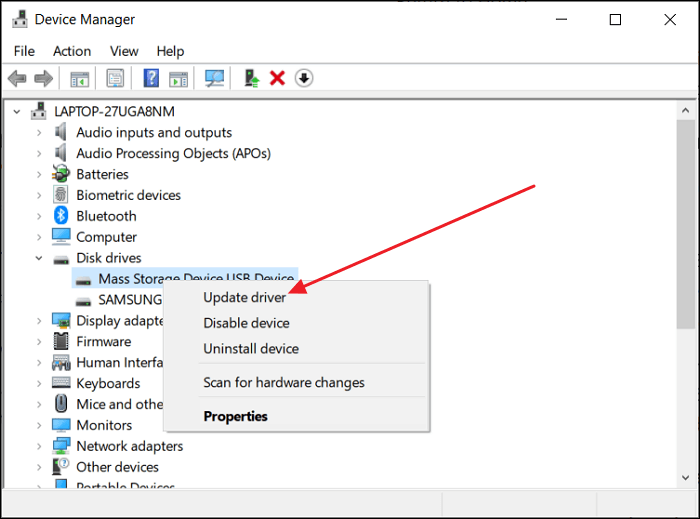
Step 8. At last, select "Search automatically for drivers" to process with the update process.
Method 3. Free Up Space on C Drive
Once you clone Windows 10 onto a new system, the C: drive might get crowded with unnecessary files and system backups from the cloning process. It can lead to a shortage of disk space, particularly problematic for SSDs where available space is vital for peak performance.
However, you can easily solve the C drive out of space by eliminating unnecessary files and programs. Besides, you can also extend the C drive and improve the performance. Download the full-featured tool - EaseUS Partition Master and see how it works to free up space on C drive:
Step 1. Click "Adjust with 1-Click" to extend C drive.
When your C drive is out of space, hover your mouse over the C drive, you will see the Low Disk Space alert on EaseUS Partition Master. Click "Adjust with 1-Click" to extend it.
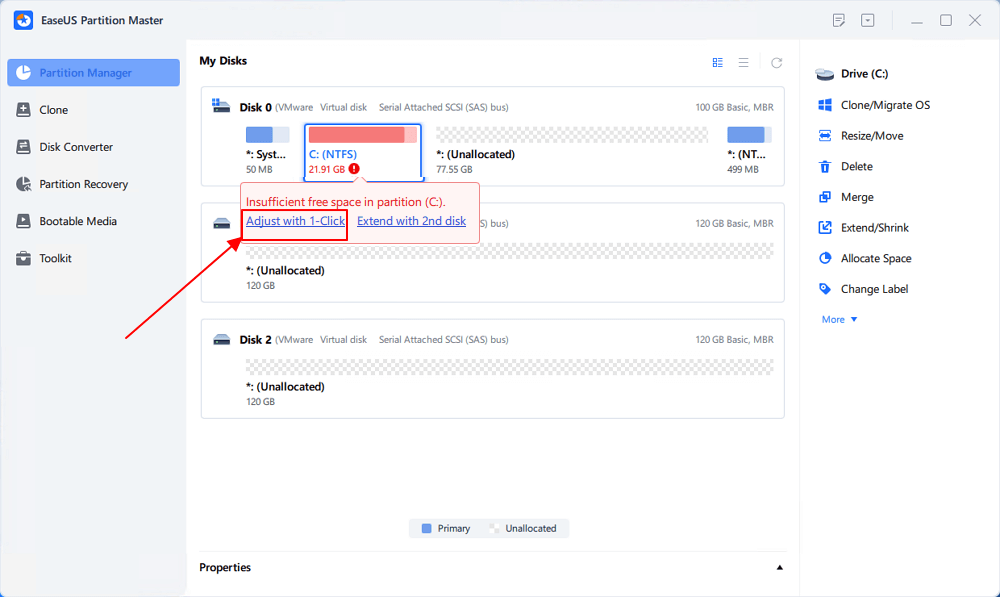
Step 2. Click "OK" to extend C drive automatically.
By clicking "OK", EaseUS Partition Master will automatically allocate space to your C drive to solve the low space issue.
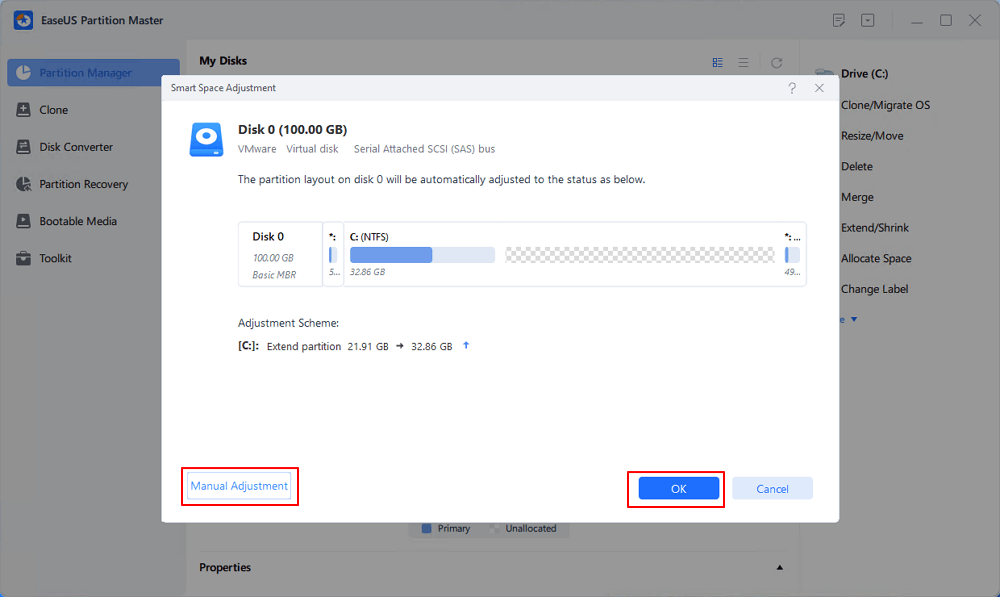
Extra Option: You can also click "Manual Adjustment" to extend the C drive manually.
When turning to Manual Adjustment, select the C drive, and drag dots rightward to add more space to C drive. Click "OK" to confirm.
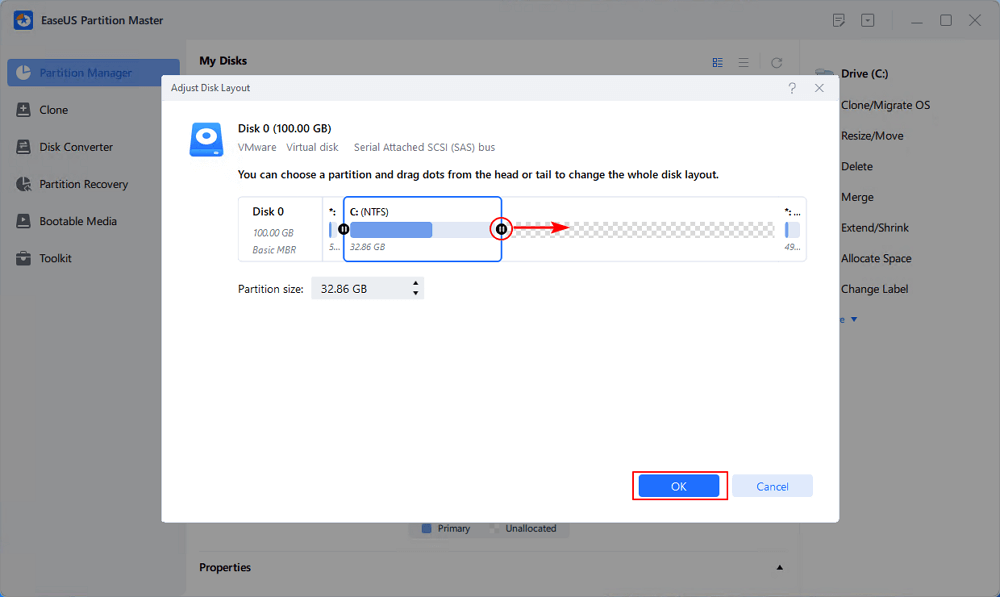
Step 3. Confirm to resolve low disk space in C drive
Click the "Execute Task" button at the top corner and start all pending operations by clicking "Apply".
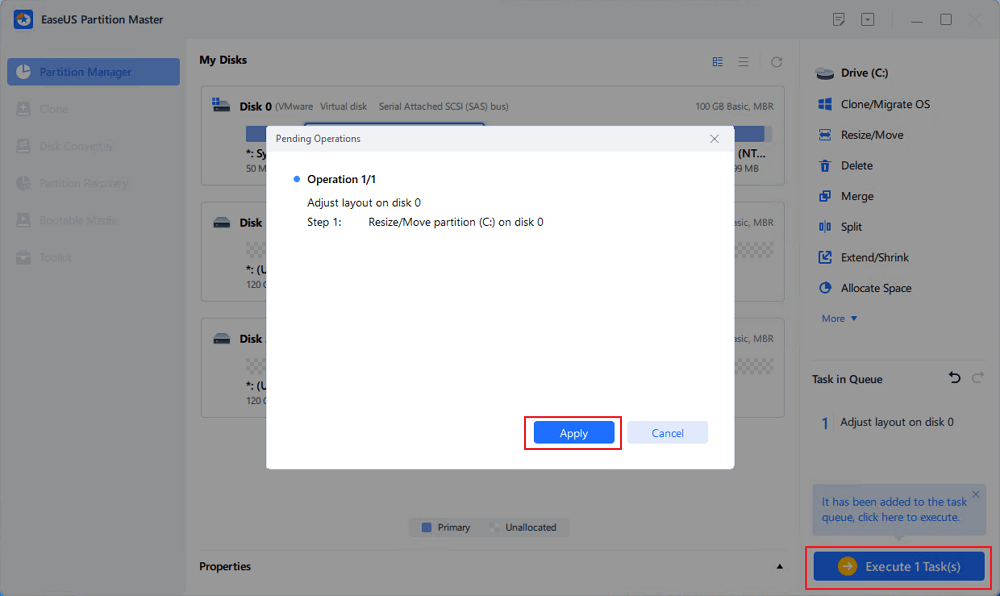
EaseUS Partition Master provides a complete solution to insufficient disk space, including:
- App Mover: Migrate software to a partition
- Resize Partition: Resize a partition by shrinking or extending it
- Delete Partition: Delete all contents of the target partition with one click.
- Clone Disk: Upgrade to a larger hard drive without losing data
Don't hesitate to download this tool and enjoy the benefits it brings to you.
Method 4. Enable TRIM for SSD
If you are still dealing with your SSD taking too long to boot after applying the above-mentioned solutions, you may need to enable TRIM. It's a command supported by modern SSDs and operating systems, which directs the SSD to selectively erase unwanted data blocks.
When you clone a Windows 10 system onto a new SSD, the operating system may not automatically enable TRIM, leading to slower performance. Follow the steps to enable it properly:
Step 1. Start by accessing the "Command Prompt" app by searching it using the Search feature and tapping the "Run as administrator" option.
Step 2. Then, type the command: "fsutil behavior set DisableDeleteNotify 0."

Step 3. Once done, press the "Enter" key and reboot your computer to enable TRIM successfully.
Method 5. Disable Disk Indexing
Disk indexing is a Windows feature that generates and updates an index of files and their contents on the disk. Although it enhances search performance, disk indexing necessitates continuous disk activity and consumes system resources to upkeep the index.
Thus, the increased disk activity and resource usage may lead to slower system performance, especially on low-end PCs. You can easily disable disk indexing by walking through the given guide to fix a laptop still slow after an SSD upgrade:
Step 1. First, access "File Explorer" by pressing the "Win + E" key and then go to "This PC."
Step 2. Afterward, open the "Properties" of the Windows drive by hitting right-click on it.
Step 3. At the bottom of the "General" tab, uncheck the box saying, "Allow files on this drive to have contents indexed in addition to file properties."
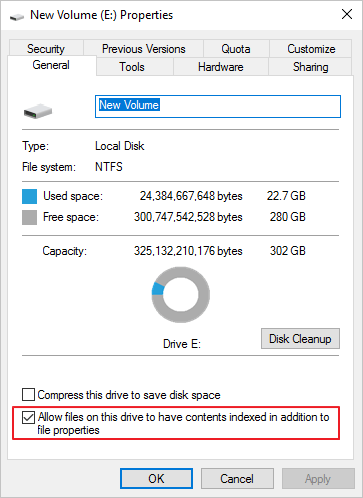
Step 4. Once done, click the "OK" button to turn off the disk indexing.
Now, check the difference if the cloned hard drive running slow issue got resolved or not.
Method 6. Disable SSD Defragmentation
Traditional hard disk drives benefit from defragmentation to improve read and write performance. In contrast, SSDs operate differently and do not need defragmentation. In fact, defragmenting can result in unnecessary write operations and performance reduction in SSD over time. To find out how you can disable it on Windows 10, look at this guide for fixing the Windows 10 slow after clone problem:
Step 1. Once again, open the "Properties" of your SSD drive from "File Explorer" and, this time, go to the "Tools" tab.
Step 2. Click the "Optimize" button in the "Optimize and defragment drive" section.
Step 3. In the next window, hit the "Change Settings" button.
Step 4. Finally, uncheck the "Run on a schedule" option and click "OK" to finalize your changes.
Method 7. Disable System Restore
System restore is essential for addressing system issues and recovering from errors, as it periodically generates restore points for Windows. Yet, it also consumes disk space and requires ongoing disk activity to maintain those points.
Therefore, you can reduce performance issues related to disk activity and storage by disabling System Restore. Follow the given steps to disable the System Restore feature on Windows 10:
Step 1. First, open the Start Menu of your Windows and type "System Restore." Then, click "Create a restore point" from the search result.
Step 2. From the new appearing window, choose your Windows drive and hit "Configure."
Step 3. Check the "Disable system protection" option and click "OK" to confirm it.
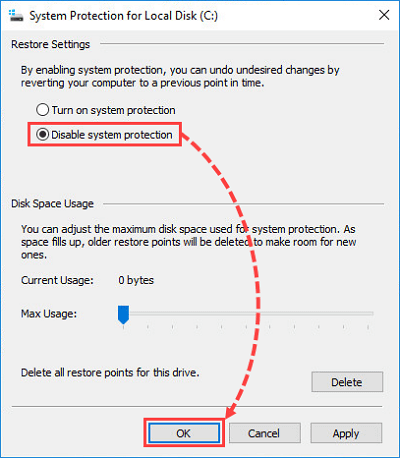
Windows OS may still run slow, even if you cloned HDD to SSD. Follow the tutorials and optimize SSD after cloning. If you think this guide is useful, click the social buttons and share it with others in need.
Final Words
All in all, Windows cloning comes with so many benefits, including saving time while setting up multiple PCs. Still, you must face some performance drawbacks due to the several factors mentioned in the article. However, you can easily deal with such problems by applying the appropriate solving methods. We have enlisted the most effective methods for the "Windows 10 slow after clone" issue.
Moreover, we have introduced you to one of the best disk manager tools you can use to optimize your disk's performance. EaseUS Partition Master can create, move, extend, merge, or format the entire partition of your disk most efficiently. Thus, instead of using multiple tools and ways to take care of your storage disk, try this all-in-one solution for free.
FAQs About Windows 10 Slow After Clone
Although we have explained enough of this topic, some additional questions may still arise in users' minds. So, you can find answers to those common questions in this section for further understanding.
1. Does cloning Windows reduce performance?
Cloning Windows itself doesn't inherently reduce performance. However, issues such as misaligned partitions, outdated drivers, or unnecessary background processes after cloning can impact performance.
2. Why is my laptop still slow after installing the SSD?
Several factors could contribute to this issue. Common reasons include outdated drivers, insufficient RAM, or software bloat. Additionally, if the SSD isn't properly optimized, performance may not fully improve.
3. What should you do after cloning Windows 10?
After cloning Windows 10, it's crucial to ensure proper setup and optimization. Fixes include:
- Updating drivers
- Enabling AHCI mode (if applicable)
- Disabling unnecessary startup programs
- Optimizing SSD settings like TRIM and defragmentation
How Can We Help You
About the Author
Updated by Tracy King
Tracy became a member of the EaseUS content team in 2013. Being a technical writer for over 10 years, she is enthusiastic about sharing tips to assist readers in resolving complex issues in disk management, file transfer, PC & Mac performance optimization, etc., like an expert.
Cici is the junior editor of the writing team of EaseUS. She accepted the systematic training on computers at EaseUS for over one year. Now, she wrote a lot of professional articles to help people resolve the issues of hard drive corruption, computer boot errors, and disk partition problems.
Product Reviews
-
I love that the changes you make with EaseUS Partition Master Free aren't immediately applied to the disks. It makes it way easier to play out what will happen after you've made all the changes. I also think the overall look and feel of EaseUS Partition Master Free makes whatever you're doing with your computer's partitions easy.
Read More -
Partition Master Free can Resize, Move, Merge, Migrate, and Copy disks or partitions; convert to local, change label, defragment, check and explore partition; and much more. A premium upgrade adds free tech support and the ability to resize dynamic volumes.
Read More -
It won't hot image your drives or align them, but since it's coupled with a partition manager, it allows you do perform many tasks at once, instead of just cloning drives. You can move partitions around, resize them, defragment, and more, along with the other tools you'd expect from a cloning tool.
Read More
Related Articles
-
SmartDisk FAT32 Format Utility & FAT32 Format Tool Free Download [2024 Updated]
![author icon]() Jean/2024/10/29
Jean/2024/10/29 -
3+ Solutions: Solve C Drive Full and Out of Space in Windows 11/10/8/7
![author icon]() Jean/2024/11/15
Jean/2024/11/15 -
(Solved!) DPC Watchdog Violation Error Windows 10
![author icon]() Tracy King/2024/10/25
Tracy King/2024/10/25 -
How to Check SSD Health on Mac | 3 Free Ways
![author icon]() Sherly/2024/12/03
Sherly/2024/12/03
Hot Topics in 2024
EaseUS Partition Master

Manage partitions and optimize disks efficiently








